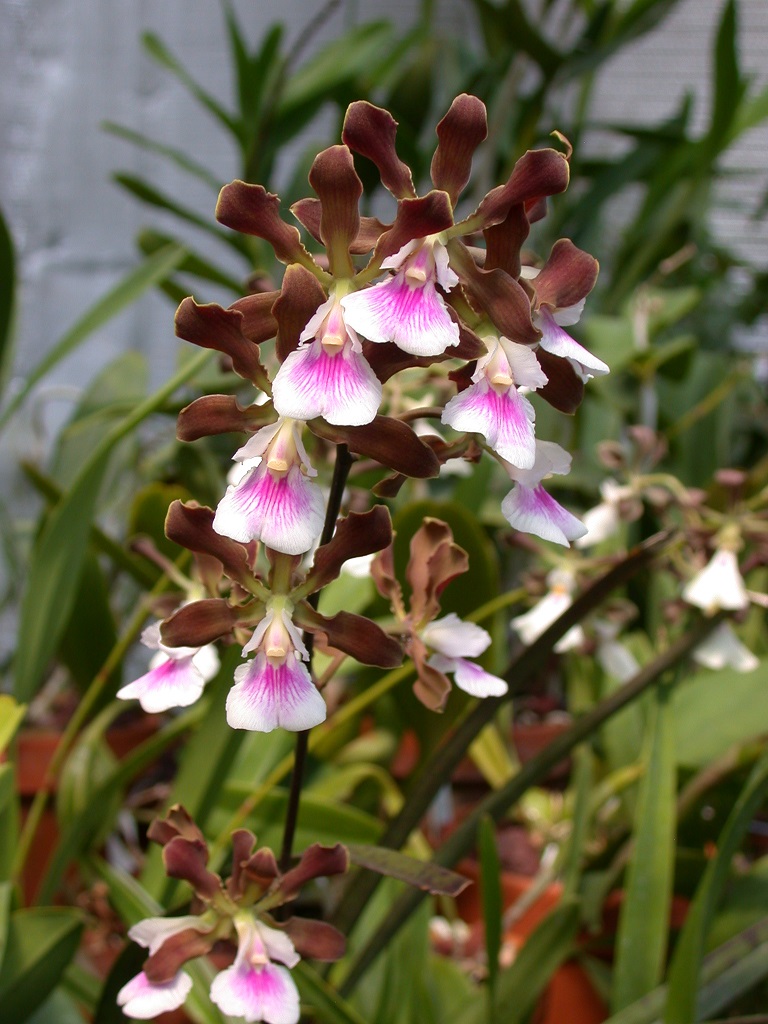
In the twenty-four years that I have been growing orchids, I have bloomed several hundred species and have seen thousands more at orchid society meetings and shows. Of them all, my favorite is Encyclia cordigera var. rosea. I love everything about this plant: the rich purple color of its flowers, the fragrance they produce only when the sun shines directly on them, the predatory appearance of the hooked sepals, the glossy pseudobulbs that can be as large or larger than a goose’s egg, and the leathery leaves that arch above.
There are three color varieties of E. cordigera in nature and in cultivation, all of them worth growing. Encyclia cordigera var. rosea is the most common variety in cultivation, and in my opinion is the best. My favorite clone is typical of line-bred specimens that have been selected for rich color and a flat lip. The fragrance of this plant is just wonderful. It reminds me of hybrid tea roses.:

I also have a second clone of E. cordigera var. rosea with a slightly paler lip whose edges curve down, but the flowers are at least a third larger than the first clone. This one came labeled as E. cordigera ‘Rubynz,’ but I have not been able to discover anything about the origin of that clonal name.

The second form of E. cordigera has pigmented sepals and petals and a white lip with a single spot of magenta near the center. My clone of this color form has a sweeter fragrance, more like candy than roses, with a hint of talcum powder.

This color form is sometimes erroneously labeled E. cordigera var. randii because of its similarity to a Brazilian species named Encyclia randii. But although they have a superficially similar color scheme, these are very different species, both in vegetative appearance and cultural requirements.

The third form, Encyclia cordigera forma leucantha has flowers that lack all red pigment, resulting in a white lip with green sepals and petals. In my clone of this form, the talcum powder smell is stronger, although the fragrance is still pleasant. The inflorescences are much shorter than those of the other two forms, so the flowers sit just above the leaves instead of arching well above them. I’m not sure if that is a characteristic of all E. cordigera f. leucantha or just my clone.

Ruben Sauleda and Pablo Esperon have recently argued that the E. cordigera with magenta-spotted white lip should be considered a separate species, Encyclia macrochila, based on its distinct color and the different appearance of its hybrids compared to those of E. cordigera var. rosea [1]. They do not mention E. cordigera f. leucantha, so it is not clear whether it would remain E. cordigera or become a form of E. macrochila. In any case, it remains to be seen whether this interpretation becomes more widely accepted by botanists. I’m not rushing to change my plant tags yet.
E. cordigera (including E. macrochila) is native to seasonally dry lowland forest from Mexico to northern South America, so it likes to be grown warm and bright in a mix that dries fairly rapidly after watering. I use chunks of scoria (red lava rock) in clay pots. My plants are grown in the half of the greenhouse that isn’t covered by shade cloth, so the sunlight is diffused only by the 8 mm twinwall polycarbonate (and accumulated dirt). In the summer, they go outside under 30% shade cloth.
The plants have a very predictable growth schedule. They initiate new growth in late spring, and by autumn the new pseudobulbs are mature. The plant then sits dormant for a couple of months, but I can usually see the inflorescences starting to grow by late January. In my greenhouse, E. cordigera f. leucantha blooms first, with the flowers opening in early to mid March. About three weeks later, the white lipped form blooms, followed by var. rosea in mid April. Individual flowers last about six weeks, so the bloom times of three forms overlap, and I often have plants in bloom through the end of May.
The previous year’s pseudobulbs also grow roots in the spring, before the growth cycle starts over again, so repotting is best accomplished in late winter. Unlike many epiphytic orchids which root on new growth, E. cordigera is not a species that you want to repot when the new pseudobulbs are growing. If you damage the roots by repotting in late spring, the plant will have to sit almost a year before it grows enough roots to recover.
With that one caveat though, E. cordigera is a generally easy species to grow and will reward even minimal effort. It’s definitely one of my retirement home plants–that is, plants I’ll grow when I am old and decrepit and can only take a few favorites with me to the retirement home.

Reference
Sauleda RP and Esperon P (2016) The proper name for a central and South American species of Encyclia Hooker. New World Orchid Nomenclatural Notes 20:1-10. Link

Love the thought encapsulated in your comment, ” It’s definitely one of my retirement home plants–that is, plants I’ll grow when I am old and decrepit and can only take a few favorites with me to the retirement home.” You can send a specimen with me when the time comes – just to make sure senility is not an impediment to good horticulture. Yer Da!
LikeLiked by 1 person